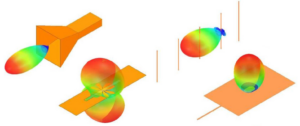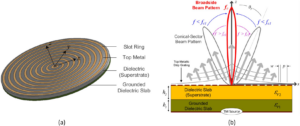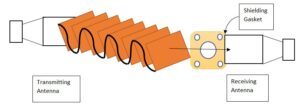Yes, UHF monopole antennas typically need a ground plane. Without one, signal coverage can be reduced by 30% to 50%. For optimal performance at 450 MHz, a 33 cm ground plane is recommended, increasing signal gain by 2 dB to 4 dB with a larger ground plane.
Unipolar antenna
A monopole antenna is a half-wavelength antenna used in communication systems in the UHF band, such as radio systems from 450 MHz to 900 MHz, where the signal coverage of a monopole antenna without a ground plane is reduced by 30% to 50%. If the ground plane of the 450 MHz band antenna is too small, the signal gain will be reduced by 3 dB.
For a UHF monopole antenna with a frequency of about 450 MHz, the ground plane needs to reach a diameter of 33 cm, and when the diameter of the ground plane is increased from 20 cm to 40 cm, the signal gain is increased from 2 dB to 4 dB. This significant boost represents an increase in coverage of about 25%.
Aluminum and copper are common ground plane materials, their high conductivity can effectively reflect electromagnetic waves, when the copper ground plane is used, the signal gain of 450 MHz UHF antenna reaches 4.5dB, when the aluminum ground plane is used, the signal gain is slightly lower, 4.0dB. In the scenario of long-distance transmission, every 0.5 dB boost when the signal is weak is very valuable.
The UHF monopole antenna installed on the car has a frequency of 450 MHz and the ground plane is the metal housing of the car body. When the vehicle is moving, the antenna’s signal coverage can reach 5 to 8 kilometers, and if the car body metal is poorly grounded, the signal coverage will be reduced to about 3 kilometers. In the installation process of outdoor TV antenna, adding a 45 cm diameter aluminum ground plane can increase the HD signal reception rate by 15%.

Dipole antenna
A dipole antenna, which does not require an external ground plane to function properly, consists of two conductors of the same length, half the wavelength of the target operating frequency. The total length of the 450 MHz dipole antenna is 33 cm, and the length of each conductor is 16.5 cm. Its signal gain is 2.15 dBi in an outdoor environment. The dipole antenna has a signal coverage of 4 to 5 kilometers in an unshielded environment, while the monopole antenna has a signal coverage of only about 3 kilometers without a ground plane.
Copper, which is 30% more expensive than aluminum, reduces signal loss when using a copper dipole antenna, with a signal gain of 2.5 dBi at 450 MHz, and slightly lower signal gain of 2.1 dBi when using an aluminum dipole antenna.
A dipole antenna can receive 30 to 40 channels in areas with good signal strength, while a monopole antenna can only receive 20 to 25 channels without a ground plane. In radio communication devices such as walkie-talkies and handheld radio devices, the signal coverage of the dipole antenna is 1 to 3 kilometers, and in cities, the signal coverage is reduced to 500 meters to 1 kilometers due to the blocking of buildings.
At 450 MHz frequency, the length of each conductor of the dipole antenna should be precisely controlled at 16.5 cm, the error should not exceed 1 cm, the antenna should be installed at a high place such as more than 10 meters from the ground, the signal gain can be increased by about 15%.

Yagi antenna
Yagi antennas, also known as Yagi Uta antennas, are used in the UHF band for television reception, radio communications, and satellite communications. The Yagi antenna consists of several elements, including an active element (a dipole antenna), a reflector, and multiple guides. The 450 MHz Yagi antenna has an active element length of 33 cm, a reflector length of 35 cm, and the nearest guide can reach about 30 cm in length.
In the 450 MHz UHF band, a Yagi antenna with five guides can achieve a signal gain of 10 dBi, and a dipole antenna can achieve a gain of only 2.15 dBi, and the coverage can be expanded by two to three times. In an open, unobserved environment, Yagi antennas can reach a signal coverage distance of 10 to 15 kilometers, while ordinary omnidirectional antennas can only cover 3 to 5 kilometers.
A UHF Yagi antenna operating at 700 MHz has an active element length of 21 cm, and an Yagi antenna with a frequency of 300 MHz has an active element length of 50 cm.
In urban high-rise buildings or mountain environments, the Yagi antenna’s strong orientation can help it penetrate obstacles to ensure signal quality. Yagi antennas in the 450 MHz band can receive more than 50 clear TV channels when receiving HDTV signals. With omnidirectional antennas, the number of channels that can be received is reduced by 20% to 30% when the signal strength fluctuates greatly.
When the Yagi antenna was increased from 5 to 8 guides, the signal gain was increased from 10 dBi to 12 dBi. The height of the Yagi antenna also affects its performance. When the antenna is installed at a height of 15 meters above the ground, the signal reception is best, and the gain is increased by about 20%. Correct adjustment of the Yagi antenna direction to the signal source is also key, the error should not exceed 3 degrees, otherwise it may lead to unstable signal reception.
Vehicle antenna
Vehicle antennas come in a variety of varieties, including monopole antennas, dipole antennas, and more complex multi-band antennas. For the common UHF band (300 MHz to 3 GHz), unipolar antennas are widely used in vehicles because the metal body of the vehicle can act as a ground plane, improving the antenna’s signal reception and transmission capabilities. A UHF monopole antenna on an ordinary car has an antenna length between 30 and 50 cm, the specific length will be adjusted according to the frequency, and the antenna length in the 450 MHz band is about 33 cm.
When the vehicle is moving, the metal body can effectively increase the signal gain of the unipolar antenna. For antennas in the 450 MHz band, the ground plane of the vehicle’s metal body can increase the signal gain by 3 to 4 dB, allowing the communication range to increase from 3 km to 5 km. Compared with antennas without a ground plane, the signal quality of the vehicle-mounted antenna is more stable in the driving, especially on open highways, and the signal coverage can extend to 10 kilometers or more.
The size and structure of the vehicle will also affect the performance of the antenna, the same 450 MHz monopole antenna, the signal gain on large trucks is 4.5dB, and the gain on small cars is 3.8dB, especially in complex terrain or urban environments, the signal penetration will be improved, and the signal reception range on the truck can be expanded by about 15%.
When the antenna is installed in the center of the roof, the signal gain can be increased by 1 to 2 dB, the UHF antenna installed in the center of the roof of an SUV has a signal coverage range of 8 kilometers, and if the antenna is installed in the rear compartment, the signal coverage is reduced to about 6 kilometers, and it is generally recommended that the antenna and the roof be 50 centimeters away to avoid signal interference caused by the antenna and the body.
In the process of vehicle driving, the signal reception and transmission of the antenna will be affected by high-speed movement, especially in the high-speed driving of more than 100 km/h, the signal gain of the antenna may be reduced by 1 to 2 dB. To compensate for this signal attenuation, performance can be improved by using higher gain antennas, or by adopting multi-band antenna systems. For example, a high-gain antenna in the 450 MHz band has a gain of 5 dB, compared with a standard 3 dB antenna, and its signal coverage can still remain stable at about 8 kilometers at high speed, without significant impact on speed.
The service life of the stainless steel antenna can reach more than 10 years, while the service life of the aluminum alloy antenna is 5 to 7 years. Carbon fiber composites are widely used in antenna systems for high-performance vehicles because of their portability and good wind resistance, and their weight is only 50% of that of stainless steel antennas, but their durability is relatively weak, and their service life is generally 3 to 5 years.







